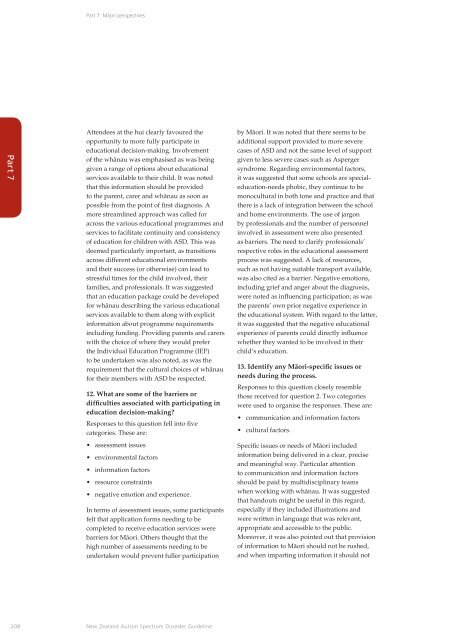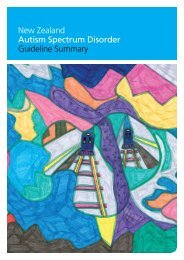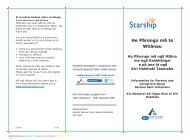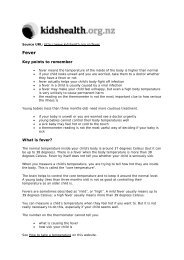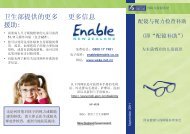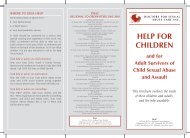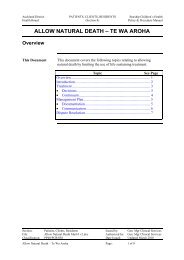New Zealand Autism Spectrum Disorder Guideline - Ministry of Health
New Zealand Autism Spectrum Disorder Guideline - Ministry of Health
New Zealand Autism Spectrum Disorder Guideline - Ministry of Health
Create successful ePaper yourself
Turn your PDF publications into a flip-book with our unique Google optimized e-Paper software.
Part 7: Mäori perspectives<br />
Part 7<br />
Attendees at the hui clearly favoured the<br />
opportunity to more fully participate in<br />
educational decision-making. Involvement<br />
<strong>of</strong> the whänau was emphasised as was being<br />
given a range <strong>of</strong> options about educational<br />
services available to their child. It was noted<br />
that this information should be provided<br />
to the parent, carer and whänau as soon as<br />
possible from the point <strong>of</strong> first diagnosis. A<br />
more streamlined approach was called for<br />
across the various educational programmes and<br />
services to facilitate continuity and consistency<br />
<strong>of</strong> education for children with ASD. This was<br />
deemed particularly important, as transitions<br />
across different educational environments<br />
and their success (or otherwise) can lead to<br />
stressful times for the child involved, their<br />
families, and pr<strong>of</strong>essionals. It was suggested<br />
that an education package could be developed<br />
for whänau describing the various educational<br />
services available to them along with explicit<br />
information about programme requirements<br />
including funding. Providing parents and carers<br />
with the choice <strong>of</strong> where they would prefer<br />
the Individual Education Programme (IEP)<br />
to be undertaken was also noted, as was the<br />
requirement that the cultural choices <strong>of</strong> whänau<br />
for their members with ASD be respected.<br />
12. What are some <strong>of</strong> the barriers or<br />
difficulties associated with participating in<br />
education decision-making?<br />
Responses to this question fell into five<br />
categories. These are:<br />
• assessment issues<br />
• environmental factors<br />
• information factors<br />
• resource constraints<br />
• negative emotion and experience.<br />
In terms <strong>of</strong> assessment issues, some participants<br />
felt that application forms needing to be<br />
completed to receive education services were<br />
barriers for Mäori. Others thought that the<br />
high number <strong>of</strong> assessments needing to be<br />
undertaken would prevent fuller participation<br />
by Mäori. It was noted that there seems to be<br />
additional support provided to more severe<br />
cases <strong>of</strong> ASD and not the same level <strong>of</strong> support<br />
given to less severe cases such as Asperger<br />
syndrome. Regarding environmental factors,<br />
it was suggested that some schools are specialeducation-needs<br />
phobic, they continue to be<br />
monocultural in both tone and practice and that<br />
there is a lack <strong>of</strong> integration between the school<br />
and home environments. The use <strong>of</strong> jargon<br />
by pr<strong>of</strong>essionals and the number <strong>of</strong> personnel<br />
involved in assessment were also presented<br />
as barriers. The need to clarify pr<strong>of</strong>essionals’<br />
respective roles in the educational assessment<br />
process was suggested. A lack <strong>of</strong> resources,<br />
such as not having suitable transport available,<br />
was also cited as a barrier. Negative emotions,<br />
including grief and anger about the diagnosis,<br />
were noted as influencing participation; as was<br />
the parents’ own prior negative experience in<br />
the educational system. With regard to the latter,<br />
it was suggested that the negative educational<br />
experience <strong>of</strong> parents could directly influence<br />
whether they wanted to be involved in their<br />
child’s education.<br />
13. Identify any Mäori-specific issues or<br />
needs during the process.<br />
Responses to this question closely resemble<br />
those received for question 2. Two categories<br />
were used to organise the responses. These are:<br />
• communication and information factors<br />
• cultural factors.<br />
Specific issues or needs <strong>of</strong> Mäori included<br />
information being delivered in a clear, precise<br />
and meaningful way. Particular attention<br />
to communication and information factors<br />
should be paid by multidisciplinary teams<br />
when working with whänau. It was suggested<br />
that handouts might be useful in this regard,<br />
especially if they included illustrations and<br />
were written in language that was relevant,<br />
appropriate and accessible to the public.<br />
Moreover, it was also pointed out that provision<br />
<strong>of</strong> information to Mäori should not be rushed,<br />
and when imparting information it should not<br />
208<br />
<strong>New</strong> <strong>Zealand</strong> <strong>Autism</strong> <strong>Spectrum</strong> <strong>Disorder</strong> <strong>Guideline</strong>


